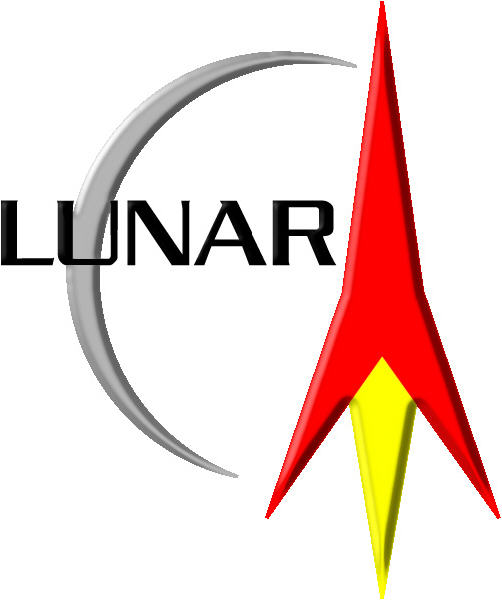 LUNAR’clips
2003
Volume 10, Number 6
LUNAR’clips
2003
Volume 10, Number 6
 LUNAR’clips
2003
Volume 10, Number 6
LUNAR’clips
2003
Volume 10, Number 6
Livermore Unit of the National Association of Rocketry November/December 2003
Copyright © 2003 by LUNAR, All rights reserved.

Armadillo Aerospace is a small research and development team, based in Mesquite, Texas, working on computer-controlled hydrogen peroxide rocket vehicles, with an eye towards X Prize-class vehicle development. Their current design for the Black Armadillo spacecraft is a single stage vehicle with nontraditional operating features. The Black Armadillo's propulsion system consists of four pressure-fed, hydrogen peroxide, monopropellant system rocket engines fed from a single tank. The propellant tank has a capacity for 1,600 gallons (6,055 liters) of hydrogen peroxide. The exhaust of a hydrogen peroxide propulsion system is environment-friendly (superheated steam and gaseous oxygen). The flight profile of the Black Armadillo starts out in a familiar fashion, but shortly after reaching the peak altitude of 107 km (67 miles), it operates in a manner which can only be described as "ground breaking." Orientation of passengers in the cabin has not been finalized. Initial acceleration of the Black Armadillo is 2 Gs, dropping off as speeds increase, and then rising again towards the end of the engine burnout. There is a much longer than typical burn because the rocket engines are used to stabilize the vehicle during ascent. The engines will burn for approximately 145 seconds, at which time the vehicle will be traveling at a speed of almost 2,300 miles per hour and will be at an altitude of almost 35 miles. After reaching apogee, the passengers continue to experience micro-gravity conditions as the vehicle begins its ballistic descent back to Earth. Once the density of the atmosphere starts to increase, the aerodynamic drag on the vehicle begins to increase and the passengers begin feeling G-forces again. After it has descended to an altitude where the air density is great enough, a small drogue chute will be deployed from the base of the vehicle to insure proper reentry, which will briefly deliver an estimated five Gs of deceleration. At approximately nine minutes into the flight and when the vehicle descends through an altitude of 1.9 miles (3 km), the main chute will be deployed. Sufficient time is given to deploy a backup chute if necessary. Approximately six minutes later, the vehicle will make contact with the ground at approximately 25 feet per second. The crushable, aluminum nose cone neatly and systematically collapses into itself, decelerating the vehicle to a stop. The capsule then falls on its side to end the mission.
On July 5, Armadillo Aerospace carried out a milestone helicopter drop test of hardware essential to the team's X Prize candidate design. For the July 5 test, the rocketeers welded in strapping points within the vehicle to hold 600-pounds (273-kilograms) of "passenger" sandbags in the cabin area. Also a set of five Olympic barbell plates were mounted on a peg at the vehicle's end to simulate the weight of the final engines, plumbing, and backup recovery system that will be on the group's full size vehicle. On close examination after touchdown, the vehicle's crushable nose cone had buckled right at the mounting point from the angled impact. Overall, the vehicle looked basically sound, Carmack reported. None of the sandbags in the cabin ruptured. John Carmack, head of Armadillo Aerospace, gave a thumbs-up regarding the success of the recent drop test. "Overall, the operation was a good success, and demonstrates that recovering the complete vehicle after flight should work fine," he later reported. A leading do-it-yourselfer in the rocket business, Carmack is perhaps better known as a founder of id software, a computer gaming company. He is also the brain behind such PC action games as Doom and Quake and is personally bankrolling his space company. Accelerometer data showed 10 G (10 times Earth's gravity) acceleration peaks during the parachute landing and bounce. That is over twice what the group saw in earlier, straight down drop tests. "This is still acceptable, although bouncing up and back down in the cabin would have been a pretty harsh ride," Carmack said. Some changes to the vehicle structure will improve the behavior of the crush cone and tipping over effects. Parachute canopy changes are being considered to reduce oscillations of the craft seen during the descent, Armadillo Aerospace officials reported. Armadillo recently purchased and received delivery of a Russian spacesuit off of eBay.
The Web site for Armadillo Aerospace is at www.armadilloaerospace.com

This team is based in Bridgewater, Massachusetts, and is led by Steve McGrath. The Vanguard series launch vehicle, the Vanguard Eagle, consists of two booster stages and spacecraft. The booster stages include fuel tank housing and solid fuel booster housings. The Vanguard Eagle follows a traditional vertical take-off and ballistic reentry mission plan. The flight begins with a vertical launch and a crew of four. The first stage will provide the primary lift-off thrust for the first 50 kilometers. The second stage will carry the Eagle to an altitude of 75 kilometers where the spacecraft will separate. The booster stages will return to Earth via parachute. After the booster fuel is exhausted, the booster stages separate, and the capsule coasts to an altitude of 100 kilometers. At apogee (the point in the orbit most distant from the center of the Earth), the crew experiences about five minutes of micro-gravity before the capsule makes a turn-around maneuver for the reentry. After the attitude thrusters orientate the Eagle capsule for reentry, with the blunt end of the crew capsule absorbing the heat of reentry, the capsule is guided on a course in a similar fashion as the capsules of the Mercury program. At the appropriate altitude, the drogue and main parachutes deploy for a splashdown and safe recovery of the crew.


All content is the responsibility of LUNAR.
If you have comments or suggestions regarding these web pages,
please contact the 
Copyright © 1992 - 2025 LUNAR